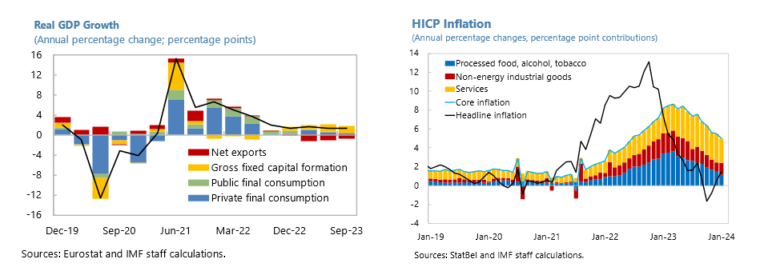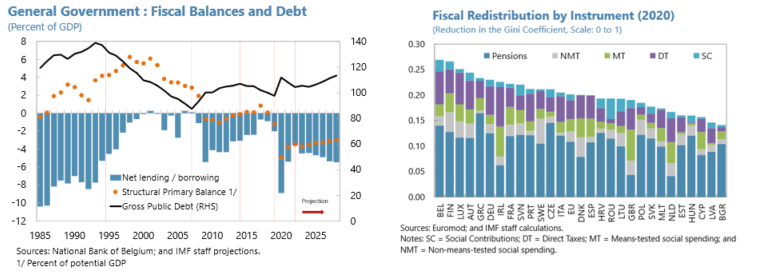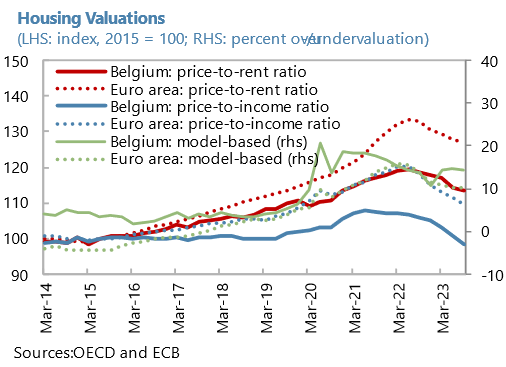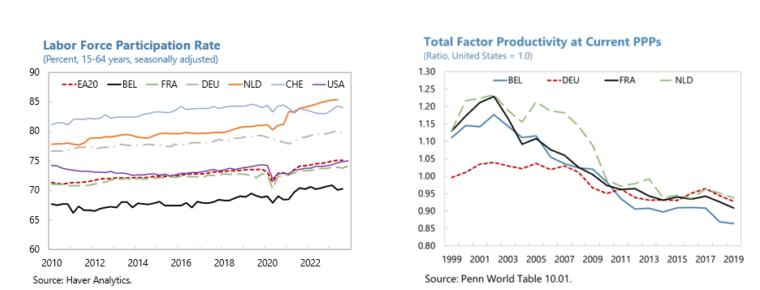Addressing Belgium’s Economic Challenges

Supported by strong and timely policy response, the Belgium economy has been resilient to a series of shocks. Still, the pandemic and energy crisis increased already-high public debt and structural fiscal deficits. At the same time, an aging population and the climate transition are putting pressure on public finances while low productivity and labor participation are dampening potential growth. Policies should continue to address this confluence of cyclical and structural challenges. Sustained and, ideally, front-loaded fiscal consolidation is needed to support disinflation, restore buffers, reduce debt, and preserve Belgium’s social model. Macroprudential policy tightening is welcome, as systemic risks are rising and additional strengthening of the financial policy framework will further insulate the economy from macro-financial shocks. Structural reforms in labour and product markets and further progress in green transition will boost potential growth and help address medium-term challenges.
Economic outlook and risks
We expect growth to decelerate further in 2024 and inflation to pick up again. Private consumption should decelerate as momentum from wage indexation, lower energy prices and post-pandemic pent-up demand ebbs. Accounting for slowing domestic demand and a weaker external environment, we see growth slowing to 1.0 percent in 2024, before returning to its potential of 1.2-1.3 percent. Headline inflation has dropped to 2.3 percent in 2023 due to sharply lower energy prices but will increase again in 2024, mostly due to the fading effects from energy price support measures. Core inflation (i.e., inflation excluding food and energy) remained elevated, at 6 percent in 2023. Labor markets are expected to remain tight.

This outlook is subject to considerable uncertainty and risks. Escalating geopolitical tensions, coupled with trade and financial flow disruptions could dampen activity in the highly open Belgian economy, undermine confidence, and reignite inflationary pressures. Monetary policy of major central banks may tighten more or for longer than presently expected, weighing on macro-financial conditions. Conversely, an insufficient monetary policy response to renewed price pressures would increase the risk of a wage-price spiral, especially with automatic wage indexation in Belgium. A protracted government formation after June elections would risk delaying the needed fiscal adjustment and reforms, increasing risk premia, and worsening debt dynamics.
Advancing Fiscal Consolidation
Belgium’s fiscal position has structurally deteriorated since the pandemic and energy crisis. In a scenario where no further adjustment would be made, the fiscal deficit would remain high and continue rising over the medium term, mainly reflecting the impact of permanent social benefit and wage measures taken during COVID-19, inflation indexation, population aging, and higher interest cost. The overall deficit would reach about 5½ percent of GDP, well above its pre-pandemic trend, and public debt would rise to about 113 percent of GDP in 2028.
Fiscal adjustment is needed to preserve Belgium’s social model, lower inflation, reduce debt, and rebuild buffers. Belgium’s social contract is characterized by a high level of redistribution and wide-reaching safety nets. The model has been successful in reducing inequality and mitigating the impact of the multiple shocks that afflicted the economy since the pandemic. However, it is generating large structural deficits and faces the pressure of an aging population on social programs. Ensuring its sustainability requires further reforms. Moreover, a tighter fiscal stance is needed to support disinflation. Meanwhile, the high public debt level exposes Belgium to changes in market sentiment. Also, limited fiscal space is constraining room to address future shocks.

Fiscal challenges call for a significant, sustained and, ideally, frontloaded consolidation. Despite efforts at the federal level, the 2024 budgetary plans will leave the general government deficit largely unchanged from 2023, because the aggregate deficit of regions and communities will increase. Compared to a baseline with no policy change, an adjustment effort of 0.8 ppts of GDP annually during 2025-30 would more than offset the increase in aging outlays and help achieve a structural balance by 2030. This higher cumulative adjustment than recommended under the proposed new EU framework would put public debt solidly on a downward path towards 60 percent of GDP in the early 2040s.
The fiscal adjustment should primarily focus on rationalizing spending and increasing its efficiency, which lags best performers. Given the high level of taxation, room for mobilizing additional tax revenue appears relatively limited. Spending has increased the most compared to pre-pandemic projections on social benefits and the public wage bill, adding about 3 percentage points and 0.6 percentage points of GDP, respectively, by 2028. Social benefits spending was 5.2 ppts of GDP higher than the average of EU advanced economies in 2021, while social outcomes did not overperform peers’, suggesting room for efficiency gains—including by reviewing the automatic-indexation mechanisms. In pursuing the fiscal adjustment, high-return public investment, crucial to boost potential growth, should be preserved.
Fiscal reforms are key to sustaining the consolidation efforts, notably in tax policy, pensions, and healthcare.
- Tax policy. The 2022 tax reform blueprint should continue to be pursued to help improve labour force participation and make the tax system fairer. It will be essential to coordinate tax reform with social security reforms to ensure consistency and align incentives. Gradually reducing or eliminating rate differentials in the VAT is desirable, with measures to cushion the impact on low-income households. Capital taxation should be more consistent across income sources, particularly regarding real estate and capital gains. The reform should be at least budget neutral and, ideally, deficit reducing.
- Pensions. The increase in minimum pension and the pension bonuses decided in 2020 and 2022, respectively, increased the system’s projected deficits in 2022-70. While measures taken in 2023 will broadly offset their cost, aging will continue to put pressure on the system over the medium term. This calls for further sustainability reforms, including to increase the effective retirement age.
- Healthcare. Health outcomes are comparatively good in Belgium but achieved at a relatively high cost, suggesting large here again potential efficiency gains. This would free resources that could help absorb part of the projected increase in spending on health, including long-term care, due to aging. Realizing these efficiency gains would require significant reforms that could include more emphasis on preventive care, reforms of the organization and role of hospitals, and greater use of generic drugs.

Fiscal adjustment efforts need to be shared among all federal entities. Coordination among federal entities is limited due to the lack of hierarchy among the federal and regional governments, and the absence of an accountability mechanism for all levels. Going forward, fiscal adjustment at the region and community levels should be part of a broader consolidation plan, with strict spending limits applied at all levels of government.
Preserving Financial Sector Resilience
The financial sector has been resilient to shocks, but systemic risks are rising from cooling real estate markets, higher interest rates, and weaker economic activity. FSAP stress tests show a high degree of resilience of bank and non-bank financial intermediaries albeit with some heterogeneity across institutions. Yet, vigilance is needed as risks are mounting. First, riskier segments of real estate lending may become vulnerable if macro-financial conditions deteriorate or structural factors (e.g., work-from-home) intensify, although the correction in the real estate cycle has been orderly so far, moderating somewhat-elevated valuations. In addition, widespread use of fixed-rate mortgages, strong household financial positions, and low commercial property vacancies provide further comfort. Second, banks could face risks from a fast-changing interest rate environment and cross border exposures. Third, vulnerabilities in corporate debt may emerge, as businesses with weaker profitability face cost pressures, tighter funding conditions, and weaker growth

In this context, the National Bank of Belgium’s (NBB) recent macroprudential policy tightening was appropriate. Reflecting the evolution of macro-financial risks, the NBB activated the counter-cyclical capital buffer while recalibrating the sectoral systemic risk buffer maintained against risks from residential mortgages. The adjustment of buffers is anticipated to add €1.6 billion in capital to absorb unexpected losses from a broader deterioration in the macro-financial environment, while preserving the ability to cushion losses from a steep housing market correction.
Financial sector oversight is well developed, but the financial policy framework could be further strengthened in several areas.
- Supervision. There is scope for the NBB to further improve the corporate governance framework of banks and monitor bank internal capital targets. The already-strong collaboration between the NBB and the Financial Services and Markets Authority can be further strengthened, notably through greater information sharing. The regulatory and supervisory framework for the insurance sector can be enhanced further. Large exposures to real estate and mortgages call for closely monitoring the quantity and quality of mortgage loans and prudent valuation by insurers. Climate resiliency would benefit from finalizing the legal framework for public-private partnerships for natural catastrophe risk.
- Macroprudential policy. In the near term, the NBB’s ability to independently implement macroprudential policy would be fortified by removing the requirement for formal government approval of macroprudential measures at least for capital requirements. Ideally, the NBB should be granted full power to set macroprudential policy, while retaining a consultative role for the Ministry of Finance.
- Crisis management and resolution. The national resolution handbook should be finalized with attention to tools outside of preferred resolution strategies. Operational readiness of resolution plans and greater internal coordination should be ensured. The emergency liquidity assistance framework should be reinforced to enhance the readiness to provide emergency liquidity for bank resolution.
Fostering Higher and Greener Growth
Continued reforms are needed to increase participation in the labor market. With low unemployment and high vacancies, especially in Flanders, attaining higher economic growth will require improvements in productivity, labor participation, and interregional mobility. Continuing labor market, tax, and social benefit reforms are needed to effectively widen the net income gap between non-work and work. Reducing skills mismatches and continuing to increase flexibility in the job market will also help. Efforts should continue to focus on greater inclusion in employment of foreign-born-particularly women, lower-skilled and older workers, and individuals with disabilities through activation policy focusing on addressing inflexibility, high dismissal costs, and red tape.

Deeper product-market reforms would help raise productivity and potential growth. Growth in total factor productivity has declined over the past two decades, bringing productivity levels below neighbouring economies. Regulation of the retail sector and most professional occupations stand out as particularly restrictive in comparison to peers. Streamlining regulation and licensing of businesses would also help. Product market reforms to align Belgium’s business environment with the average in European advanced economies or the three best-performing peers could eventually lift total factor productivity by about 3½ percent and 7½ percent, respectively.
Green transition needs more ambitious climate goals, supported by additional measures and improved federal-regional coordination. The extension of two nuclear reactors’ life and investment in additional renewable energy and LNG capacity will help lower Belgium’s carbon footprint and support energy security. Still, emissions from activities not included in the EU emissions trading system (ETS) are projected to decline less under Belgium’s updated National Energy and Climate Plan that EU targets. Greater coordination of federal and regional entities would help accelerate climate policy decisions and execution. The planned EU ETS expansion to buildings, road transport and small industry should be complemented by higher carbon taxation, reduction of fossil fuel subsidies, sectoral feebates, and price floors/ceilings to ensure sufficient payback from investment in low-carbon technologies. Part of revenues from carbon taxation could be employed to support vulnerable households during the green transition.
The tasks ahead are challenging but manageable under a shared objective to achieve inclusive growth and improve living standards of living. Timely policy action and steadfast implementation is key.
Authors


